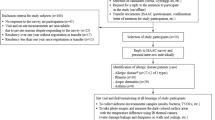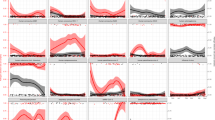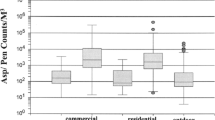Abstract
The results of a traditional visual mold inspection were compared to a mold evaluation based on the Relative Moldiness Index (RMI). The RMI is calculated from mold-specific quantitative PCR (MSQPCR) measurements of the concentration of 36 species of molds in floor dust samples. These two prospective mold evaluations were used to classify the mold condition in 271 homes of infants. Later, the development of respiratory illness was measured in the infants living in these homes and the predictive value of each classification system was evaluated.
The binary classification of homes as either moldy or non-moldy by on-site visual home inspection was not predictive of the development of respiratory illness (wheeze and/or rhinitis) (P=0.27). Conversely, a method developed and validated in this paper, using the RMI index fit to a logistic function, can be used to predict the occurrence of illness in homes and allows stake-holders the choice among various levels of risk.
This is a preview of subscription content, access via your institution
Access options
Subscribe to this journal
Receive 6 print issues and online access
$259.00 per year
only $43.17 per issue
Buy this article
- Purchase on Springer Link
- Instant access to full article PDF
Prices may be subject to local taxes which are calculated during checkout


Similar content being viewed by others
References
Belanger K., Beckett W., Triche E., Bracken M.B., Holford T., Ren P., McSharry J.E., Gold D.R., Platts-Mills T.A., and Leaderer B.P. Symptoms of wheeze and persistent cough in the first year of life: associations with indoor allergens, air contaminants, and maternal history of asthma. Am J Epidemiol 2003: 158: 195–202.
Benjamini Y., and Hochberg Y. Controlling the false-discovery rate: a practical and powerful approach to multiple testing. J Royal Stat Soc Series B 1995: 57: 289–300.
Biagini J.M., LeMasters G.K., Ryan P.H., Levin L., Riponen T., Burkle J, and Lockey J. Environmental risk factors in rhinitis in early infancy. Pedi Allergy Immunol 2006: 17: 278–284.
Brinkman N.E., Haugland R.A., Wymer L.J., Byappanahalli M., Whitman R.L., and Vesper S.J. Evaluation of a rapid, quantitative real-time PCR method for cellular enumeration of pathogenic Candida species in water. Appl Environ Microbiol 2003: 69: 1775–1782.
Cho S.-H., Reponen T., LeMasters G., Levin L., Huang J., Meklin T., Villareal M., and Berstein D.I. Mold damage in homes and wheezing in infants. Ann Allergy Asthma Immunol 2006 (in press).
Haugland R.A., Brinkman N.E., and Vesper S.J. Evaluation of rapid DNA extraction methods for the quantitative detection of fungal cells using real time PCR analysis. J Microbiol Meth 2002: 50: 319–323.
Haugland R.A., Varma M., Wymer L.J., and Vesper S.J. Quantitative PCR of selected Aspergillus, Penicillium and Paecilomyces species. Sys Appl Microbiol 2004: 27: 198–210.
Helsel D.R. Nondetects and Data Analysis, Statistics for Censored Environmental Data, Wiley and Sons, Inc., NY, NY. Environmental Data. Wiley and Sons Inc.: Hoboken, NJ 2005.
Institute of Medicine, National Academies of Science. Damp Indoor Spaces and Health. The National Academies Press: Washington, DC, 2004, p. 355.
International Study of Asthma and Allergies in Childhood (ISAAC) Steering Committee. Worldwide variation in prevalence of symptoms of asthma, allergic rhinoconjunctivitis, and atopic eczema: ISAAC. Lancet 1998: 351: 1225–1232.
Kercsmar C.M., Dearborn D.G., Schluchter M.D., Xue L., Kirchner H.L., Sobolewski J., Greenberg S.J., Vesper S.J., and Allan T.M. Urban mold and moisture project: asthma intervention. Environ Health Perspect 2006: 114: 1574–1580.
Mannino D.M., Homa D.M., Akinbami L.J., Moorman J.E., Gwynn C., and Redd S.C. Surveillance for asthma-United States, 1980–1999. MMWR 2002: 51 (ss01): 1–13.
Meklin T., Haugland R.A., Reponen T., Varma M., Lummus Z., Bernstein D., Wymer L.J., and Vesper S.J. Quantitative PCR analysis of house dust can reveal abnormal mold conditions. J Environ Monitor 2004: 6: 615–620.
Osborne M., Riponen T., Adhikari A., Cho S.-H., Grinshpun S.A., Levin L., Biagini J., Bernstein D.I., and LeMasters G. Specific fungal exposures, allergic sensitization, and rhinitis in infants. Pedi Allergy Immunol 2006: 17: 450–457.
Ryan P.H., LeMasters G., Biagini J., Bernstein D., Grinshpun S.A., Shukla R., Wilson K., Villareal M., Burkle J., and Lockey J. Is it traffic type, volume, or distance? Wheezing in infants living near truck and bus traffic. J Allergy Clin Immunol 2005: 116: 279–284.
Venables W.N., and Ripley B.D. Modern Applied Statistics with S-Plus, 3rd edn Springer-Verlag Inc.: NY, 2000.
Vesper S.J. Developing the EPA Relative Moldiness Index© based on mold specific quantitative PCR. Synergist 2006: 2: 39–42.
Vesper S.J., McKinstry C., Yang C., Haugland R.A., Kercsmar C.M., Yike I., Schluchter M.D., Kirchner H.L., Sobolewski J., Allan T.M., and Dearborn D.G. Specific Molds Associated with Asthma. J Occup Environ Med 2006: 48: 852–858.
Vesper S.J., Varma M., Wymer L.J., Dearborn D.G., Sobolewski J., and Haugland R.A. Quantitative PCR analysis of fungi in dust from homes of infants who developed idiopathic pulmonary hemorrhaging. J Occup Environ Med 2004: 46: 596–601.
Waegemaekers M., Van Wageningen N., Brunekreef B., and Boleij J.S.M. Respiratory symptoms in damp homes. Allergy 1989: 44: 192–198.
Zock J.-P., Jarvis D., Luczynska C., Sunyer J., and Burney P. Housing characteristics, reported mold exposure, and asthma in the European Community Respiratory Health Survey. J Allergy Clin Immunol 2002: 110: 285–292.
Acknowledgements
We are grateful to all parents and children who participated as well as to all home visit teams, subject recruitment teams, and clinic personnel of the CCAAPS. This research was supported by the National Institute of Environmental Health Sciences (NIEHS) Grant No. RO1 ES11170 awarded to the University of Cincinnati. This research was also supported by funding from the EPA Asthma Initiative.
Author information
Authors and Affiliations
Corresponding author
Additional information
Disclaimer
The U.S. Environmental Protection Agency (EPA), through its Office of Research and Development, funded and collaborated in the research described here. It has been subjected to the Agency's peer review and has been approved as an EPA publication. Mention of trade names or commercial products does not constitute endorsement or recommendation by the EPA for use.
MSQPCR technology was patented by the US EPA (# 6 387 652). Thus, the EPA has a financial interest in the commercial use of this technology.
Rights and permissions
About this article
Cite this article
Vesper, S., Mckinstry, C., Haugland, R. et al. Relative moldiness index as predictor of childhood respiratory illness. J Expo Sci Environ Epidemiol 17, 88–94 (2007). https://doi.org/10.1038/sj.jes.7500528
Received:
Accepted:
Published:
Issue Date:
DOI: https://doi.org/10.1038/sj.jes.7500528
Keywords
This article is cited by
-
Indoor Fungal Exposure and Allergic Respiratory Disease
Current Allergy and Asthma Reports (2015)
-
Microbial volatile organic compound emissions from Stachybotrys chartarum growing on gypsum wallboard and ceiling tile
BMC Microbiology (2013)
-
Correlation between ERMI Values and Other Moisture and Mold Assessments of Homes in the American Healthy Homes Survey
Journal of Urban Health (2009)



